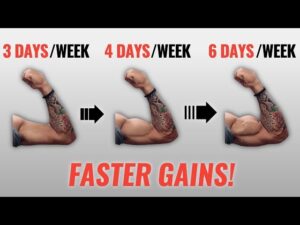Which of the following is NOT a short-term fitness goal?
A. Working out 3 times a week
B. Losing 1 pound per week
C. Establishing healthier nutritional habits
D. Eating twice as many fruits each day
Answer: C. Establishing healthier nutritional habits
Understanding Short-Term Fitness Goals
When it comes to fitness, setting goals is essential for staying motivated and tracking progress. Goals can be divided into short-term and long-term ones. Short-term goals are objectives you can achieve in a relatively short period, usually within weeks or a few months. Long-term goals, on the other hand, take a longer time to accomplish and often involve lifestyle changes.
In this article, we’ll explore why “Establishing healthier nutritional habits” is not considered a short-term fitness goal compared to the other options listed.
Working Out 3 Times a Week
An example of a short-term fitness goal is to work out three times a week. This goal is specific and can be easily tracked. You can plan your workouts, such as doing cardio on Monday, strength training on Wednesday, and yoga on Friday. This goal is short-term because you can achieve it within a week, and it helps to create a routine that supports your long-term fitness journey.

Why it works: This goal is effective because it is manageable and provides immediate results. Regular exercise has many benefits, including improved heart health, increased strength, and improved mood. By committing to three workouts a week, you’re laying the foundation for a sustainable fitness routine.
How to achieve it: Start by choosing activities you enjoy. If you like dancing, consider a Zumba class. If you prefer being outdoors, try jogging or hiking. The key is to find exercises that you look forward to, making it easier to stick to your plan.
Losing 1 Pound Per Week
Another short-term goal is losing one pound per week. This goal is measurable and realistic. By tracking your calorie intake and ensuring you burn more calories than you consume, you can aim to lose one pound every week. This steady progress can motivate you and lead to significant weight loss over time.

Why it works: Setting a goal to lose one pound per week is attainable and doesn’t require drastic changes to your lifestyle. It encourages you to make healthier food choices and increase your physical activity gradually.
How to achieve it: Focus on creating a calorie deficit by combining a balanced diet with regular exercise. Use tools like food diaries or mobile apps to track your intake and expenditure. Small changes, such as reducing portion sizes and choosing healthier snacks, can make a big difference.
Eating Twice as Many Fruits Each Day
Eating twice as many fruits each day is also a short-term goal. You can start implementing this goal immediately by incorporating more fruits into your daily meals. For example, if you usually eat one apple a day, you can start eating two apples. This goal is achievable within a day and helps improve your nutrition.

Why it works: Increasing your fruit intake boosts your nutrient intake, providing essential vitamins, minerals, and antioxidants. Fruits are also low in calories and high in fiber, which can help with weight management and digestion.
How to achieve it: Incorporate fruits into your meals and snacks. Add berries to your breakfast cereal, have an apple with lunch, or enjoy a fruit salad for dessert. Keep a variety of fruits on hand to keep things interesting.
Establishing Healthier Nutritional Habits
Establishing healthier nutritional habits is a long-term goal. This goal involves making significant changes to your overall diet and eating patterns, which takes time and consistency. It’s not something that can be achieved quickly. Developing healthier nutritional habits requires planning, learning about balanced diets, and gradually changing your eating behaviors.

Why it works: Long-term dietary changes lead to sustainable health benefits. By focusing on overall nutrition, you’re more likely to maintain a healthy weight, improve energy levels, and reduce the risk of chronic diseases.
How to achieve it: Start by educating yourself about balanced diets and healthy eating. Set small, manageable goals, such as reducing sugary drinks or increasing vegetable intake. Over time, these small changes will add up to significant improvements in your diet.
Why Are Short-Term Goals Important?
Short-term goals are crucial because they provide immediate targets to aim for. Achieving these goals gives you a sense of accomplishment and keeps you motivated. Here are some benefits of setting short-term fitness goals:
Manageable Steps: Breaking down your long-term goals into smaller, short-term ones makes them more manageable and less overwhelming.
Quick Wins: Short-term goals provide quick wins that boost your confidence and keep you engaged in your fitness journey.
Tracking Progress: These goals help you track your progress and make adjustments as needed. For instance, if you aim to work out three times a week and find it too challenging, you can adjust to two times a week initially.
Building Habits: Achieving short-term goals helps in building habits that contribute to long-term success. For example, consistently working out three times a week can turn into a routine that supports your overall fitness.
How to Set Effective Short-Term Fitness Goals
Setting effective short-term fitness goals involves following the SMART criteria: Specific, Measurable, Achievable, Relevant, and Time-bound.
Specific: Your goal should be clear and specific. Instead of saying, “I want to exercise more,” say, “I will walk for 30 minutes every day.”
Measurable: You should be able to measure your progress. For example, “I will lose 1 pound per week” is measurable.
Achievable: Your goal should be realistic and achievable. Setting a goal to run a marathon next week is not realistic if you haven’t been training.
Relevant: Your goal should be relevant to your overall fitness objectives. If your main goal is to build muscle, then setting a goal to lift weights three times a week is relevant.
Time-bound: Your goal should have a deadline. For example, “I will increase my daily fruit intake for the next two weeks.”
Examples of Short-Term Fitness Goals
Here are a few more examples of short-term fitness goals:
Walking 10,000 Steps a Day: This goal can be tracked with a pedometer or a fitness tracker. It’s specific, measurable, achievable, relevant, and time-bound.
Drinking 8 Glasses of Water a Day: This goal helps improve hydration and can be easily tracked daily.
Trying a New Workout Class: Setting a goal to try a new workout class within the next week can keep your fitness routine exciting and fresh.
Stretching for 10 Minutes Every Morning: This goal helps improve flexibility and can be easily incorporated into your daily routine.
Creating a Balanced Fitness Plan
To achieve your fitness goals, it’s important to create a balanced fitness plan that includes a mix of different types of exercise and healthy eating habits. Here are some tips for creating a balanced plan:
Cardio Exercise: Include activities that get your heart rate up, such as running, cycling, or swimming. Aim for at least 150 minutes of moderate cardio or 75 minutes of vigorous cardio each week.
Strength Training: Incorporate strength training exercises at least two days a week. This can include weight lifting, resistance band exercises, or bodyweight exercises like push-ups and squats.
Flexibility and Stretching: Include activities that improve flexibility, such as yoga or stretching routines. Aim to stretch all major muscle groups at least twice a week.
Healthy Eating: Focus on a balanced diet that includes a variety of fruits, vegetables, whole grains, lean proteins, and healthy fats. Limit processed foods, sugary drinks, and excessive amounts of unhealthy fats.
Staying Motivated
Staying motivated is key to achieving your fitness goals. Here are some tips to keep you motivated:
Set Clear Goals: Clearly define your short-term and long-term goals. Write them down and keep them somewhere visible as a reminder.
Track Your Progress: Keep a journal or use a fitness app to track your progress. Celebrate your achievements, no matter how small.
Find a Workout Buddy: Exercising with a friend can make your workouts more enjoyable and keep you accountable.
Mix It Up: Keep your workouts interesting by trying new activities and changing your routine. This prevents boredom and keeps you engaged.
Reward Yourself: Set up a reward system for reaching your goals. Treat yourself to something you enjoy, like a new workout outfit or a relaxing massage.
Conclusion
Setting both short-term and long-term fitness goals is essential for a balanced and successful fitness journey. While short-term goals provide immediate motivation and quick wins, long-term goals help you make lasting changes. Understanding the difference between the two and setting SMART goals can significantly improve your chances of success.
In summary, “Establishing healthier nutritional habits” is not a short-term fitness goal because it involves long-term changes to your diet and lifestyle. In contrast, goals like working out three times a week, losing one pound per week, and eating twice as many fruits each day are short-term goals that can be achieved more quickly and provide immediate motivation.
By focusing on both short-term and long-term goals, you can stay motivated and make continuous progress on your fitness journey.
For more information on setting fitness goals, you can check out this helpful guide on Healthline. Additionally, Mayo Clinic’s tips on fitness planning can provide further insights into effective goal setting.




